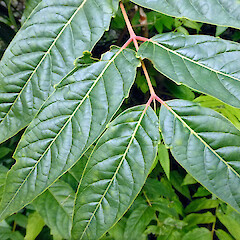Ailanthus altissima
Common name
tree of heaven
Family
Simaroubaceae
Flora category
Vascular – Exotic
Structural class
Trees & Shrubs - Dicotyledons
NVS code
The National Vegetation Survey (NVS) Databank is a physical archive and electronic databank containing records of over 94,000 vegetation survey plots - including data from over 19,000 permanent plots. NVS maintains a standard set of species code abbreviations that correspond to standard scientific plant names from the Ngä Tipu o Aotearoa - New Zealand Plants database.
AILALT
Conservation status
Not applicable
Detailed description
Smooth stems with pale grey bark, and twigs which are light chestnut brown, especially in the dormant season. Large compound leaves, 1-4 feet in length, are composed of 11-25 smaller leaflets and alternate along the stems. In late spring, clusters of small, yellow-green flowers appear near the tips of branches (Jil Swearingen pers. com). The wood of ailanthus is soft, weak, coarse-grained, and creamy white to light brown in colour. All parts of the tree, specially the flowers, have a strong, offensive odour, which some have likened to peanuts or cashews. (Rod Randall”s database)
Similar taxa
One to several glandular pads/teeth on the at the base of the leaflets (Webb et al 1988).
Flowering
October, November
Flower colours
Green, Yellow
Fruiting
Autumn
Life cycle
The species is dioecious, with male and female flowering on separate trees (Jil Swearingen pers. com.). Seeds are produced on female trees in late summer to early fall, in flat, twisted, papery structures called samaras, which may remain on the trees for long periods of time. Reproduces both sexually (seeds) and asexually (vegetative sprouts). Established trees produce numerous suckers from the roots and resprout vigorously from cut stumps and root fragments (ibid.). Prolific seed producer, One study reports that an individual tree can produce as many as 325,000 seeds per year (ibid.). Seeds are produced on female trees in late summer to early fall, in flat, twisted, papery structures called samaras, which may remain on the trees for long periods of time. (ibid.)
Origin
China
Reason for introduction
Ornamental
Etymology
ailanthus: From the Chinese ailanto, the native name for one of the species and meaning ‘tall enough to reach the skies’
National Pest Plant Accord species
This plant is listed in the 2020 National Pest Plant Accord. The National Pest Plant Accord (NPPA) is an agreement to prevent the sale and/or distribution of specified pest plants where either formal or casual horticultural trade is the most significant way of spreading the plant in New Zealand. For up to date information and an electronic copy of the 2020 Pest Plant Accord manual (including plant information and images) visit the MPI website.







